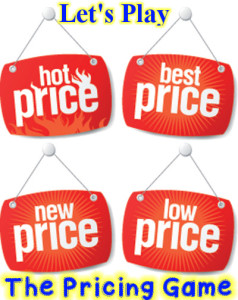You may charge $20 per pole class. As classes are not filled you decide dropping the price to $15 will fill the classes. Should you have to fill classes again or a competitior lowers their price, will you drop prices to $10, half of your starting price? This is an example of the  Pricing Game.
Pricing Game.
You can reach a point where your pricing with full classes does not cover your business expenses.
Pricing like most things in business requires research and planning. Pricing should never only be a reflection of other studios or a lack of current customers. While your pricing might end up being less than competitors, you must consider many items.
- Distance to Competing Classes
- Quality of Instructors
- Length of Classes
- Additional Materials Provided
- Quality of Studio Facility
- Number of Poles per Student
- Quality of Poles
- Parking
- Access to Public Transportation
- Community Reputation
If you think competitors prices always dictate your price, you are not in control of your own business. Mercedes-Benz, Lexus & Rolls Royce are not playing the pricing game yet are very profitable businesses. For the Rolls Royce of Pole Studios your students will pay for the quality. Of course you must be realistic. You might think you are the best but if that is not known and communicated to potential students they will not pay a premium. Mercedes-Benz sold the first automobile back in 1888 but it took them many years to build the reputation for quality they now enjoy. It should not take you years if you market your business well. If you studio does not offer the high end of the above listed items you must also consider that in your pricing strategy.
Prices must also be sufficient to cover the expenses of the classes. That is all expenses: percentage of rent, electric, advertising, equipment, etc. Do not forget to include the all important instructor even if that instructor is yourself! You are not in business to lose money. Your time is money. If your pricing makes you work for free, then why are you in business?
